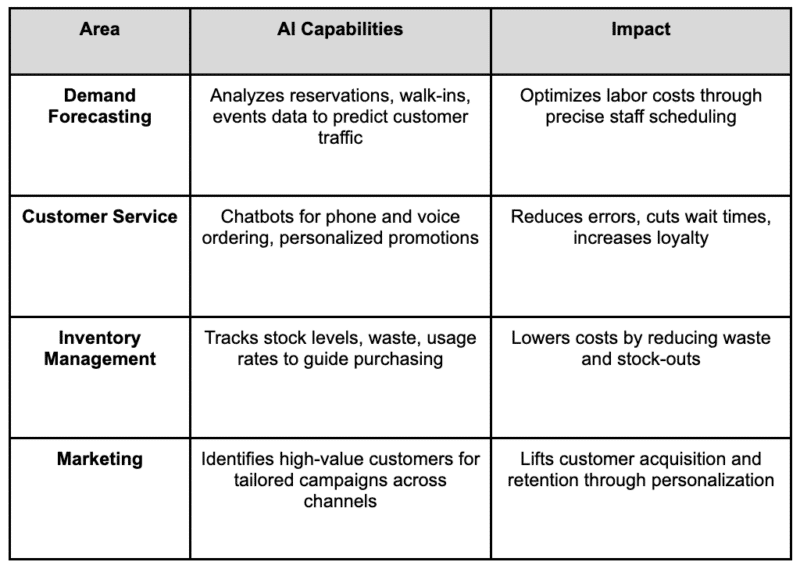Feeling overwhelmed trying to schedule the right amount of staff to handle fluctuating customer demand? Do last-minute callouts throw off your inventory orders and sales projections? As a restaurant operator, effectively managing your workforce to deliver quality service despite uncertainties is extremely challenging.
But what if you could accurately predict traffic patterns and optimize labor costs instead of relying on guesswork? By leveraging real-time data and artificial intelligence, restaurants can operate smarter, not harder. Read on as we explore how AI-powered technologies are radically reshaping workforce management.
From precisely scheduling employees based on projected sales volume to automated inventory tracking and personalized marketing, AI promises to help your restaurant boost efficiency, improve customer satisfaction, reduce waste, and enhance data-driven decision-making across operations. The future is here. Let’s dig in.
Introduction to AI in Workforce Management
Artificial intelligence allows restaurants to leverage data, machine learning algorithms, and predictive analytics to optimize complex workforce management responsibilities that humbly rely on human judgment alone.
This ultimately enables precise labor requirements forecasting to perfectly align staff scheduling with customer volume across service roles like servers, cooks, dishwashers, and cleaning crew.
The advantages of using AI for restaurants are significant: enhancing staff productivity, elevating customer satisfaction, and driving cost savings by reducing unnecessary downtime and preventing understaffing during peak times.
AI-Driven Forecasting for Demand and Staffing
Restaurants face challenges in aligning labor with fluctuating diner traffic, leading to overstaffing or understaffing. AI-driven forecasting, considering historical data and external factors, resolves this issue by predicting customer volume hourly.
Improving Customer Service with AI
Customer interactions encompass a variety of restaurant staff duties from servers politely rushing to bus tables, phone attendants scrambling during back-to-back reservation calls, and overwhelmed hosts attempting to monitor wait lists and seat guests promptly.
During dining rushes, service quality can decline due to errors in orders, long call holds, and inaccurate table wait time estimates. Automating customer service with AI reduces these issues, with chatbots managing calls and voice ordering systems improving order accuracy. AI also optimizes staff scheduling and enhances hospitality, leading to increased satisfaction, loyalty, and sales.
AI in Streamlining Inventory Management
Excess food waste stemming from imperfect guesswork in inventory control and purchasing plagues restaurant profitability. But AI overcomes such manual guesswork through granular analysis of historical point-of-sale data, inventory logs, supplier pricing fluctuations, and even pricing elasticity.
Machine learning algorithms identify ideal inventory levels, detect abnormal usage fluctuations to prevent sudden stock-outs, and trigger cost-efficient reorder points in an automated fashion. Monitoring expiration dates, AI platforms also suggest dynamic pricing adjustments for ingredients nearing freshness cutoffs to curb unnecessary write-offs.
AI’s Role in Enhancing Marketing Efforts
Gauging the optimal combination of promotional campaigns and channels represents an imperfect science for restaurants, often resulting in disappointing returns on marketing investments. AI sharpens measurement here by ingesting customer data to determine the highest-value patron personas based on historical frequency, recency, engagement levels, and purchase behaviors.
Identifying segments most likely to respond favorably, AI then orchestrates tailored messaging across the appropriate mix of email, social, direct mail, and ad platforms. Continually optimizing campaigns using performance data, AI learns over time to improve conversion rates. Guest profiles also inform automated loyalty programs to incentivize repeat business.
The Future of AI in the Restaurant Industry
Experts project stunning growth ahead in adoption of artificial intelligence in restaurant industry as the technology proves its immense utility across operations, marketing, and workforce management.
Upcoming capabilities: personalized promotions based on customer behavior, voice-based food ordering via smart speakers, real-time inventory adjustments using supply chain data, and meal recommendations from dish popularity and local ingredients.
Customer engagement itself may transform with AI chatbots providing personalized greetings and suggestions through tablets on dining tables. The bottom line is AI will redefine every aspect of restaurants – a differentiator for competitive brands and an indispensable capability for staying relevant in an increasingly data-driven dining sector.
Key Benefits of AI for Restaurants

Frequently Asked Questions
How does AI improve workforce management in restaurants?
AI boosts workforce efficiency by forecasting sales and traffic to inform better staff scheduling. It also automates administrative tasks so employees can focus on customer service.
Can AI help restaurants control costs?
Absolutely! AI curbs expenses in inventory management by reducing waste, optimizing purchasing decisions, and enhancing portion control. It also boosts workforce productivity, so less staff spends idle time during slow periods.
What are the biggest benefits of AI for restaurants?
Top benefits include increased customer satisfaction thanks to quicker service, greater loyalty through personalization, lower operational costs, and enhanced decision-making driven by data insights.
Which restaurant roles can be augmented by AI?
AI can assist nearly every role – front and back of the house – including servers, phone attendants, kitchen staff, inventory controllers, managers, marketers, and more through predictive analytics and automated capabilities.
Is AI an advantage mainly for large restaurant chains?
Not at all. Independent restaurants stand to gain immensely as well since AI platforms level the playing field for small to mid-sized establishments to leverage data-driven decisions for competitive advantages in efficiency, costs, and customer experiences.
Conclusion
In an evolving restaurant landscape, mastering workforce management and marketing through data-driven artificial intelligence is becoming crucial. This shift from reliance on human judgment to AI-driven insights is evidenced by its significant improvements in demand forecasting, inventory control, customer targeting, and satisfaction. With experts predicting that machine learning algorithms will soon permeate every operational facet, establishments stand to thrive by leveraging their customer data for predictive purposes.
Published by: Martin De Juan










